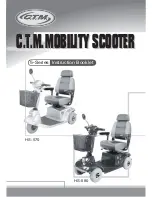
page 67 • DENAGO
One can design a part that is so strong that fatigue life is nearly infinite.
This requires a lot of material and a lot of weight. Any structure that must be light and strong
will have a finite fatigue life. Aircraft, race cars, motorcycles all have parts with finite fatigue lives.
If you wanted an Ebike with an infinite fatigue life, it would weigh far more than any Ebike sold
today. So we all make a tradeoff: the wonderful, lightweight performance we want requires that
we inspect the structure.
•
ONCE A CRACKS STARTS IT CAN GROW
AND GROW FAST
. Think about the crack as
forming a pathway to failure. This means that
any crack is potentially dangerous and will
only become more dangerous.
SIMPLE RULE 1:
If you find crack,
replace the part.
•
CORROSION SPEEDS DAMAGE.
Cracks grow
more quickly when they are in a corrosive
environment. Think about the corrosive
solution as further weakening and extending
the crack.
SIMPLE RULE 2:
Clean your Ebike, lubricate
your Ebike, protect your Ebike from salt,
remove any salt as soon as you can.
•
SIGNIFICANT SCRATCHES, GOUGES, DENTS
OR SCORING CREATE STARTING POINTS FOR
CRACKS.
Think about the cut surface as a focal
point for stress (in fact engineers call such
areas “stress risers,” areas where the stress
is increased). Perhaps you have seen glass
cut? Recall how the glass was scored and then
broke on the scored line.
SIMPLE RULE 4:
Do not scratch, gouge or
score any surface. If you do, pay frequent
attention to this area or replace the part.
• S
OME CRACKS (particularly larger ones)
MAY MAKE CREAKING NOISE AS YOU RIDE.
Think about such a noise as a serious warning
signal. Note that a well-maintained Ebike will
be very quiet and free of creaks and squeaks.
SIMPLE RULE 5:
Investigate and find the
source of any noise. It may not a be a crack,
but whatever is causing the noise should be
fixed promptly.
What to look for











































